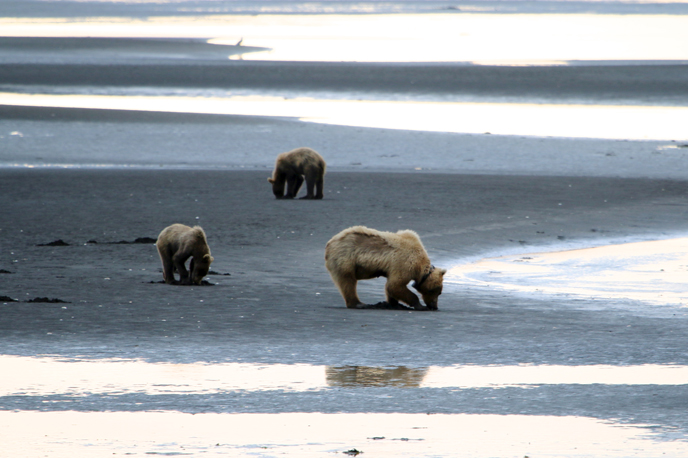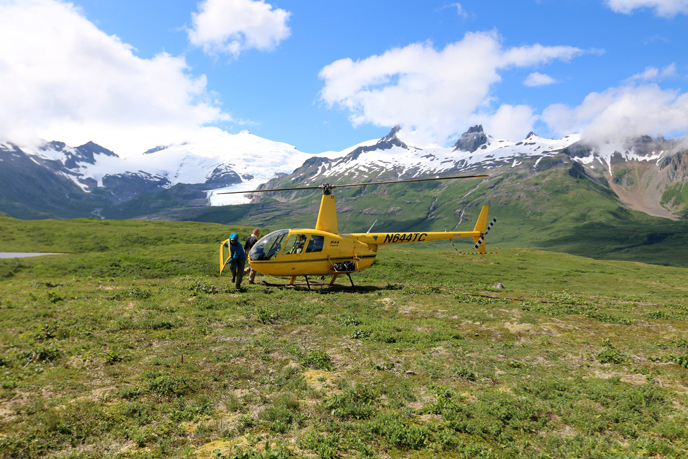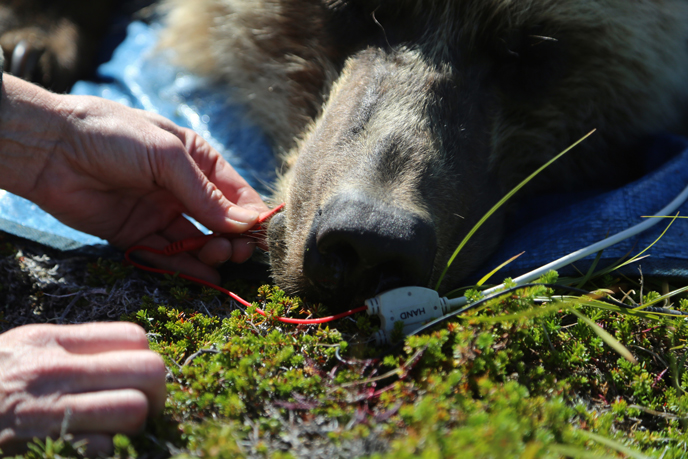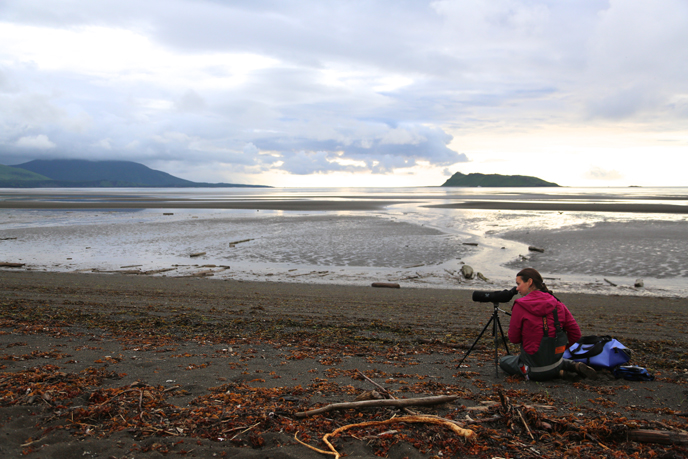On Katmai’s coast, eight female bears are currently collared with GPS devices. The collars represent one initiative of Changing Tides, a three-year research project. The collars transmit location information on a daily basis, which provides researchers with details on the bears’ home ranges and how their movements correspond to seasonal food availability.
After the collars were placed on the bears in May, six of the sows were recaptured in July in order to run tests, collect physical samples, and upload more complex data from the collars. In October, the collared sows will be captured again in order to collect a final round of samples and remove the collars prior to hibernation. In the event that some of the sows cannot be recaptured, there is an automatic mechanism installed on the collars that will cause them to fall off.
 Bear 085 is one of several bears that was fitted with a GPS collar this spring. In this photo, she and her cubs dig for clams at Hallo Bay. NPS photo.
Bear 085 is one of several bears that was fitted with a GPS collar this spring. In this photo, she and her cubs dig for clams at Hallo Bay. NPS photo.
Tranquilizing wild animals requires considerable skill, and we have an excellent team working here in Katmai. The team is headed by Grant Hilderbrand, a national trainer in helicopter darting, and includes Joy Erlenbach, the Hallo Bay researcher whose posts appear on this blog. I asked Joy for a rundown on the process of helicopter darting as it is practiced in Katmai, which she was kind enough to provide.
Changing Tides darting operations are done from a helicopter carrying a crew of three. The helicopter patrols the coastal area between Cape Douglas and Hallo Bay (approximately 30 miles). Bears must be darted in safe terrain (e.g., away from water sources, on level surfaces, etc). When a suitable bear for darting has been located, the helicopter drops off the third person outside the area, as well as the helicopter’s rear door. This is to reduce weight, improve maneuverability, and remove all obstacles for the shooter. Bears are darted with minimal chase, and are asleep within minutes. After confirming that the bear is safely down, the pilot collects their third team member and lands near the bear to begin processing.
 Dropping off the third passenger and the rear door minimizes the pursuit time prior to capture. NPS/K. Chritz.
Dropping off the third passenger and the rear door minimizes the pursuit time prior to capture. NPS/K. Chritz.
Processing involves collecting samples and taking measurements from the sleeping bear, as well as uploading information directly from the collars. The first task is to the weigh the bear, accomplished by rolling her onto a net, and then ratcheting it up onto a large tripod. By October, just before hibernation, some of these sows may weigh 800 pounds! After the weight is taken, the bear is placed on her belly with front paws outstretched and back legs extended. Researchers measure length, head size, claws, and hair growth. A bioelectric impedence analysis, or BIA, is administered via lip clamp to determine the bear’s percentage of body fat. Lastly, samples are taken of the bear’s blood (from a vein in the front leg), claw, hair, and stool. Processing takes the team about 25 minutes per bear.
 A bioelectric impedence analysis determines the bear's percentage of body fat. Comparing these results with the bears' GPS locations helps determine which areas contain the best food resources for them. NPS/K. Chritz.
A bioelectric impedence analysis determines the bear's percentage of body fat. Comparing these results with the bears' GPS locations helps determine which areas contain the best food resources for them. NPS/K. Chritz.
With processing complete, the team leaves the area. Weather is always a serious factor in Katmai, and the team’s operations are often cut short due to poor flying conditions. The day concludes with a final sweep to ensure that all darted bears are back up, and that all family groups have been reunited. It usually takes an hour to two hours for a bear to be back on its feet, with grogginess remaining somewhat longer. In general, darted bears have been observed behaving normally within 24 hours of tranquilization.
Of the collared sows, only bear 085 has been observed between captures, as she and her two cubs often fish in Hallo Bay. Joy, from her post on the beach, is understandably excited to see them, and takes especially detailed field notes. All of the July recaptures were full of promising information, and the GPS locations continue to come in each day, friendly updates on the status of these eight sows.
The Changing Tides project is providing valuable information about the link between terrestrial and marine ecosystems in Katmai. By performing detailed scans of bear activity on the Hallo Bay mudflats, and comparing them to GPS data on the locations of the collared bears, researchers and park managers can better understand the importance of marine food sources (such as clams, mussels, salmon, and flounder) to coastal brown bears. As ocean temperatures and acidity levels increase, this will help us evaluate the potential impacts upon the bears. It will also better our abilities to plan out disaster response strategies (e.g., oil spills), and to talk to the State and other entities about offshore development (such as off shore drilling) and its potential impacts to the parks.
 Joy Erlenbach surveys the Hallo Bay mudflats, with a view of Ninagiak Island, two miles from the beach. The GPS data from bear 085's collar shows that she and her two cubs spent several weeks on that island. NPS/K. Chritz.
Joy Erlenbach surveys the Hallo Bay mudflats, with a view of Ninagiak Island, two miles from the beach. The GPS data from bear 085's collar shows that she and her two cubs spent several weeks on that island. NPS/K. Chritz.
